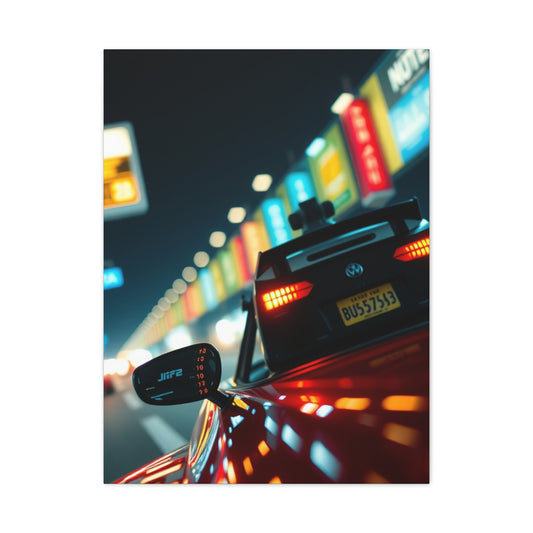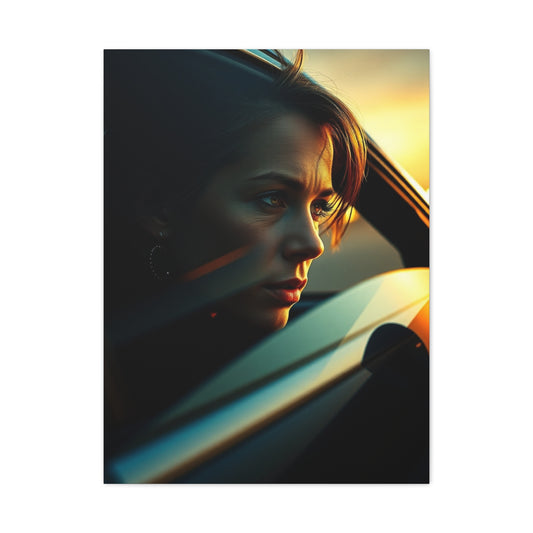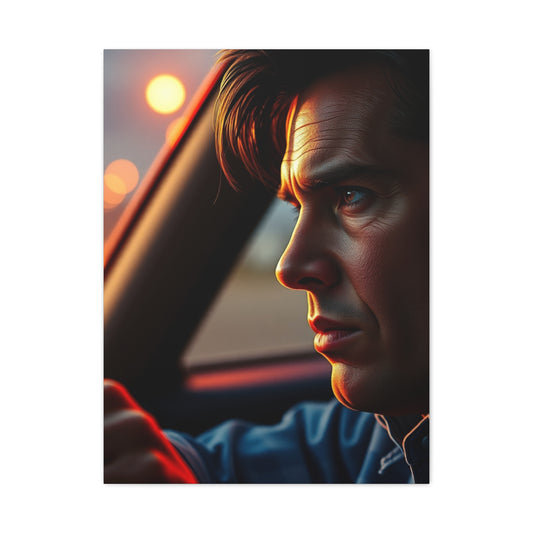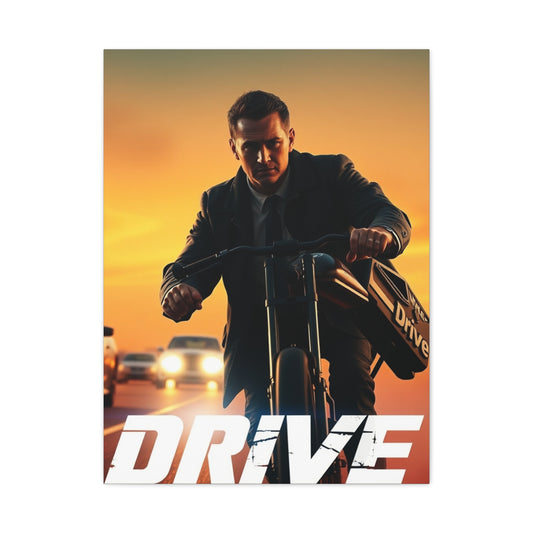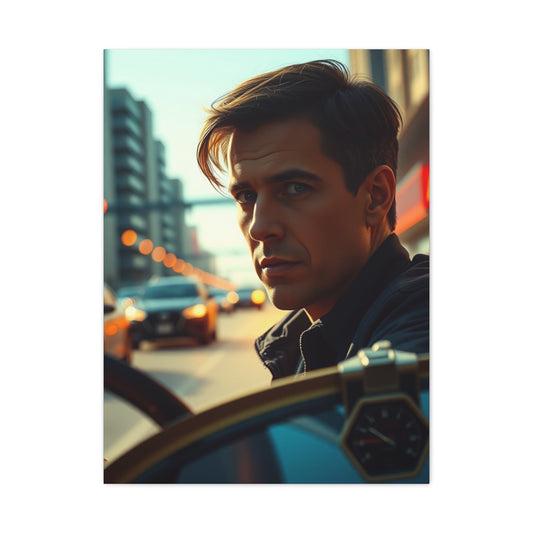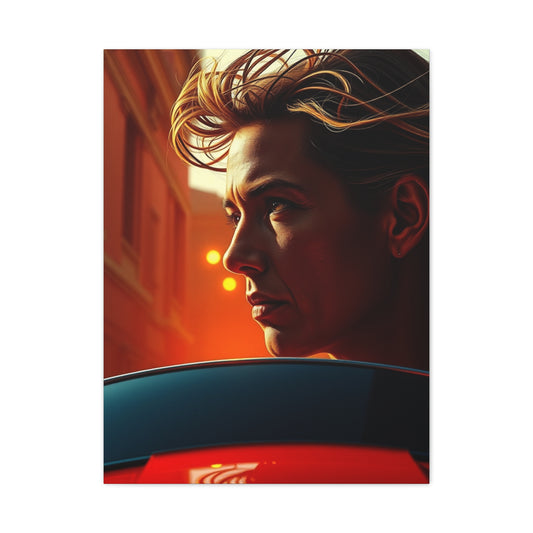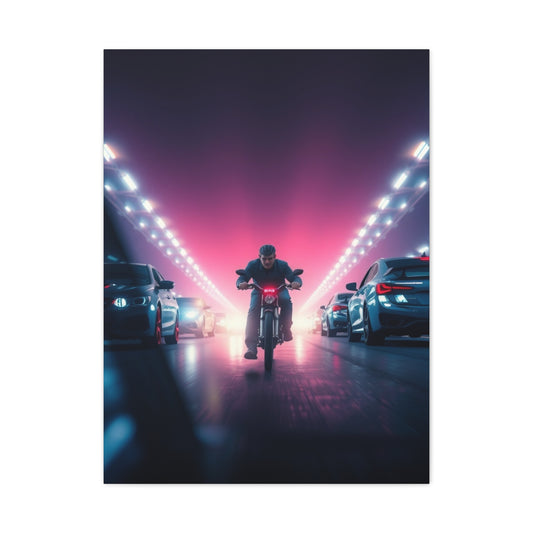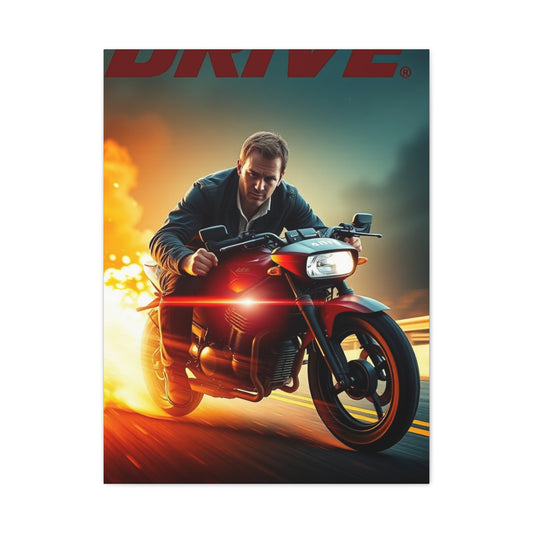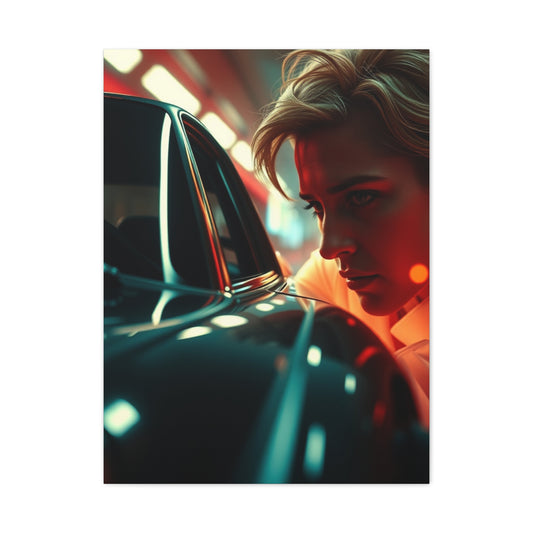The Aesthetic World of Drive Wall Art and Film Design
Drive, directed by Nicolas Winding Refn and released in 2011, represents an exemplar of modern neo-noir filmmaking. The film premiered to critical acclaim at the Cannes Film Festival, where Refn received the Best Director award, highlighting the precision and audacity of his vision. At the heart of the story is the character known simply as the Driver, portrayed by Ryan Gosling. By day, he is a meticulous stunt driver and mechanic, navigating engines and car frames with dexterity. By night, he assumes the dangerous role of a getaway driver for criminals, existing in a liminal space between legality and immorality.
The Driver’s quiet life intersects with that of his neighbor, Irene, brought to life by Carey Mulligan, and her son Benicio. When Irene’s husband, Standard, returns from prison, the Driver finds himself drawn into the treacherous underworld of Los Angeles, encountering figures such as Bernie Rose and Nino. The narrative is deceptively simple: a man attempting to protect those he cares about while confronting the inescapable consequences of his own nature. Yet beneath the surface, the film is a labyrinthine exploration of morality, instinct, and human connection.
Character Analysis: The Enigma of the Driver
The Driver is a study in restraint and controlled violence. Gosling’s performance emphasizes minimalism in dialogue and expression, reminiscent of archetypal loners in classic noir cinema. Unlike traditional protagonists who articulate their motivations, the Driver communicates through gesture, gaze, and motion. His silence is a deliberate artistic choice, reinforcing his enigmatic presence and leaving much of his psychology to be inferred by the audience.
The duality of the Driver’s existence mirrors the tension between societal expectation and innate impulse. By day, he is a craftsman, a figure of patience and precision, working within the structured environment of a film set or garage. By night, he inhabits the chaotic, morally ambiguous realm of criminal enterprise. This dichotomy aligns with the symbolic presence of the scorpion embroidered on his jacket. Drawing inspiration from the fable of the Scorpion and the Frog, the motif underscores the inexorability of inherent nature: the Driver may strive to protect Irene and her family, yet his instincts predispose him to violence, just as the scorpion’s sting is unavoidable.
Irene and Benicio: Anchors of Humanity
Irene and her son Benicio serve as emotional counterweights to the Driver’s detachment. Mulligan’s portrayal of Irene conveys vulnerability, resilience, and subtle tension, reflecting the precariousness of ordinary life amidst extraordinary circumstances. Benicio represents innocence and the capacity for trust, anchoring the Driver to a world beyond crime. Their interactions are often understated, relying on visual cues and the unspoken rhythm of shared moments.
The relationship dynamics between the Driver and Irene are particularly significant. Early scenes establish intimacy through mundane gestures—car rides, brief conversations, and shared silences. Yet even within these quotidian moments, Refn imbues a sense of foreboding. Irene’s red sweater, for instance, is more than a costume choice; it is a visual emblem of danger, attachment, and vulnerability, signaling both her emotional state and her entanglement with the Driver’s world.
Narrative Tension and the Role of Standard
Standard, Irene’s husband, is a catalyst for conflict. His return from incarceration destabilizes the fragile equilibrium of the Driver’s quiet existence. The narrative tension escalates as Standard becomes entangled with Los Angeles’ criminal underbelly, setting the stage for the Driver’s moral and physical challenges. Oscar Isaac’s portrayal infuses Standard with a quiet desperation and an aura of unpredictability, highlighting the precariousness of life for those who traverse the boundaries of legality.
The film’s narrative structure cleverly intertwines character arcs with escalating stakes. Standard’s actions inadvertently provoke confrontations with mobsters Bernie Rose and Nino, pulling the Driver into situations that test his skill, composure, and ethical code. Through these interactions, Refn crafts a tense narrative in which every decision carries moral weight, reinforcing the film’s exploration of cause and consequence.
Directorial Vision: Refn’s Cinematic Language
Nicolas Winding Refn’s direction is both meticulous and audacious. His visual style employs long takes, fluid camera movements, and precise framing, creating sequences that are simultaneously immersive and contemplative. One exemplary early scene involves the Driver preparing for a stunt on a film set. A mirror in the scene first reflects the lead actor in makeup, then pivots to reveal Gosling’s character transforming the mask. This seamless, extended take demonstrates Refn’s mastery of spatial choreography and visual narrative, echoing the innovations of classical cinema while situating the film firmly within contemporary neo-noir aesthetics.
The juxtaposition of mundane and extraordinary elements is a hallmark of Refn’s vision. By emphasizing long shots, silent moments, and deliberate pacing, the director allows tension to accumulate organically. Each frame is composed with an acute awareness of visual rhythm, inviting viewers to observe minute details that reinforce character psychology and thematic resonance.
The Symbolism of the Scorpion
The Driver’s jacket, adorned with a scorpion emblem, operates as a leitmotif throughout the film. Beyond its aesthetic appeal, the scorpion functions as a metaphor for the Driver’s inherent nature. The fable of the Scorpion and the Frog tells of a creature unable to resist its instinct to sting, even when such action ensures mutual destruction. Similarly, the Driver’s actions are dictated by a moral code intertwined with violence; he seeks to protect and preserve, yet his very nature predisposes him to harm.
The motif manifests in pivotal moments, such as the elevator scene where the Driver confronts a threatening man. His protective instincts clash with his violent tendencies, illustrating the tension between desire for change and immutable personal impulses. Through this emblem, Refn visualizes a philosophical inquiry into the human condition: to what extent are individuals capable of transcending their essential nature?
Visual Storytelling Through Color
Color in Drive functions as a silent narrative agent, reinforcing mood, character, and thematic undertones. The triadic scheme of red, blue, and yellow is employed with deliberation and subtlety. Red predominates in scenes of violence or danger, enveloping the characters and environment in a sense of urgency and threat. For example, when the Driver confronts a villain at a workplace, the pervasive red hues in carpets, walls, and reflections evoke a sensation of encroaching peril and moral entrapment.
Blue, in contrast, is associated with sanctuary, warmth, and moments of introspection. It colors spaces such as the Driver’s garage and apartment, as well as intimate interactions with Irene. This color coding delineates zones of relative safety from those of extreme risk, while simultaneously reflecting the emotional resonance of the characters’ internal states.
Yellow is applied sparingly yet meaningfully, often signifying transitions in emotion, awareness, or moral alignment. From lighting shifts to the vibrancy of the scorpion emblem, yellow punctuates the narrative and accentuates transformative moments, guiding the audience through the evolving emotional landscape of the film.
Early Visual Motifs and Cinematic Techniques
The film employs recurring visual motifs to enrich storytelling. Reflections, mirrors, and carefully composed perspectives emphasize duality, perception, and the intersection of reality and illusion. In addition to the mirror scene during the stunt preparation, Refn frequently frames characters in reflective surfaces or through geometric compositions that suggest entrapment, choice, or observation. These techniques deepen the audience’s engagement with character psychology while showcasing an extraordinary command of cinematic form.
Lighting is equally instrumental. Neon glow, ambient urban luminescence, and controlled use of shadow create an atmospheric palette that is at once hyperreal and evocative of classical noir. The interplay of light and shadow enhances tension, highlights narrative pivots, and transforms the cityscape of Los Angeles into a character in its own right—one that is alluring, dangerous, and perpetually shifting.
Sound Design and Emotional Resonance
Sound is leveraged as a narrative conduit in Drive, often bridging emotional and spatial dimensions. The soundtrack, composed by Cliff Martinez, blends ambient electronic textures with diegetic sound to create a sense of rhythm and psychological intimacy. Tracks such as “Under Your Spell” are introduced subtly within the diegetic environment before transitioning to prominence in key sequences, connecting characters across narrative space and time.
This approach to sound design reinforces the Driver’s internal experience. Moments of silence, punctuated by abrupt noise—such as the startling gunshots in a pawn shop robbery—draw viewers into the visceral reality of his existence. By manipulating auditory perception, Refn heightens suspense, underscores psychological tension, and communicates narrative information without relying on dialogue.
Minimalism in Dialogue and Its Impact
Dialogue in Drive is sparse but deliberate. The Driver’s laconic nature contrasts sharply with the verbosity of other characters, emphasizing his detachment and singular focus. Minimalist dialogue allows visual storytelling to dominate, compelling audiences to interpret meaning from gesture, posture, and gaze. This economy of speech heightens suspense and reinforces the Driver’s enigmatic presence, aligning with the broader neo-noir tradition in which silence and observation speak volumes.
Other characters’ dialogue is strategically loaded with subtext. For example, an early handshake with Bernie Rose subtly conveys power dynamics, tension, and unease without overt exposition. Such exchanges reflect the film’s meticulous narrative design, where even minor interactions carry thematic weight.
The Role of the City: Los Angeles as a Character
Los Angeles in Drive transcends mere setting. The city’s nocturnal streets, neon signage, and industrial backdrops constitute a living environment that shapes character action and mood. The urban landscape mirrors the duality of the Driver’s life: vibrant, alluring, and yet permeated by danger and moral ambiguity. Through careful framing, lighting, and color composition, the city becomes an extension of the narrative, reflecting the inner states of the characters and amplifying the tension inherent in their choices.
Escalation of Conflict: The Driver’s Descent
As Drive progresses into its middle act, the tension within the narrative intensifies, revealing the inexorable pull of the Driver’s dual existence. The film’s rhythm gradually shifts from contemplative quietude to moments of explosive violence, underscoring the thin line separating the Driver’s professional skill and personal morality. After Standard’s return from incarceration, the Driver’s protective instincts are tested as Irene’s family becomes entangled with the Los Angeles criminal underworld. The narrative stakes are heightened with the introduction of Bernie Rose, portrayed with chilling poise by Albert Brooks, and the formidable enforcer Nino, played by Ron Perlman. These antagonists are not merely obstacles; they are embodiments of systemic menace, testing the Driver’s capacity to navigate violence with precision and discretion.
In these sequences, the Driver’s quietude functions as both a shield and a weapon. He observes, calculates, and acts with deliberate economy, creating a tension that pervades the film. This period of the narrative allows the audience to see the consequences of choices and the inevitability of moral compromise. The Driver’s character becomes increasingly complex, as his internal conflict between the desire for connection and the inevitability of violence is laid bare.
Visual Symbolism and Color Dynamics
Color continues to play a critical narrative role as the plot intensifies. Refn’s visual strategy employs red, blue, and yellow not merely as aesthetic devices but as conduits for emotional resonance and narrative clarity. Red remains predominant in scenes of aggression or moral corruption. One notable instance occurs during a confrontation with Nino’s enforcers, where the environment is suffused with crimson hues. Carpets, walls, and reflective surfaces are saturated with red, evoking a sense of suffocating peril. The color envelops the characters, visually conveying the psychological and physical stakes of their encounter.
Blue, conversely, delineates zones of safety, intimacy, and emotional warmth. The Driver’s garage, his apartment, and moments shared with Irene are frequently bathed in soft or neon blue tones. These instances provide visual relief and reinforce the emotional significance of his interactions with those he seeks to protect. The interplay between red and blue throughout the mid-film sequences accentuates the tension between threat and sanctuary, external violence and internal longing, chaos and calm.
Yellow, applied with more subtlety, signals pivotal emotional transitions or moral shifts. The scorpion emblem on the Driver’s jacket, rendered in vibrant yellow, becomes a visual signifier of his innate tendencies and moral limitations. Yellow also appears in lighting that illuminates moments of realization, decision-making, and vengeance, linking the visual palette to narrative psychology. For example, a scene in which Irene contemplates her attachments while wearing her red sweater is overlaid with a subtle yellow tint, emphasizing the shift in emotional tone and foreshadowing imminent danger.
The Elevator Scene: Tension Personified
One of the film’s most studied sequences, the elevator scene, encapsulates Refn’s mastery of visual storytelling, color, and sound. The Driver, Irene, and an armed assailant share a confined space where narrative and psychological tension converge. Here, the interplay of colors, spatial dynamics, and sound design communicates the Driver’s internal conflict and the imminent threat. Irene’s vulnerability is accentuated through costume and color—her red sweater signals danger, attachment, and emotional exposure. The Driver’s movements, deliberate and calculated, reflect his protective instincts, while the assailant’s presence transforms the environment into a microcosm of violence and anticipation.
Lighting design in this scene is particularly noteworthy. Yellow and red tones interweave with the spatial confinement, reinforcing the sense of moral and physical entrapment. The choreography of movement, coupled with minimal dialogue, allows tension to accumulate naturally, demonstrating how Refn conveys psychological complexity without reliance on exposition. The scene’s impact is magnified by the juxtaposition of stillness and sudden, violent action, embodying the thematic duality that pervades the film.
Sound Design and Psychological Engagement
Sound in Drive is integral to the narrative, functioning as both diegetic and non-diegetic expression of character psychology. The film often utilizes diegetic sound to root the audience in the Driver’s immediate experience, whether it be the hum of a car engine or the ambient resonance of the city at night. In contrast, non-diegetic tracks such as Desire’s “Under Your Spell” provide an aural connection between characters, transcending spatial separation and signaling emotional alignment. The careful modulation of sound intensity and source creates a symbiotic relationship between visual and auditory storytelling, immersing the audience in the Driver’s perspective.
This sophisticated sound strategy is especially evident during moments of sudden violence. In a pawn shop robbery, the film employs near silence prior to a gunshot, heightening the shock and simulating the Driver’s own state of disbelief. The suddenness of auditory stimuli mirrors the sudden intrusion of chaos into his ordered life, reinforcing narrative tension. Through these techniques, Refn transforms sound into an instrument of suspense, anticipation, and emotional insight.
Mid-Film Violence and Character Evolution
The escalation of physical violence in Drive serves a dual purpose: it reinforces the Driver’s lethal skill set while exposing the fragility of his attempts at normalcy. In two pivotal scenes, the Driver becomes covered in blood, signaling both literal and metaphorical transformation. His blue denim jacket during early confrontations is darkened with crimson, visually linking him to violence while maintaining his association with moral reflection and intimacy. Later, when the iconic white jacket is bloodied during climactic sequences, it symbolizes the irreversibility of his choices and the merging of his violent and human selves.
These instances underscore the thematic exploration of inevitability and moral determinism. The Driver is not inherently malevolent; rather, his abilities and circumstances propel him into acts of extreme violence. Refn’s visual treatment of these sequences—long takes, precise framing, and color emphasis—ensures that each act of aggression is both narratively and aesthetically resonant.
Character Interactions and Power Dynamics
Mid-film interactions between the Driver and antagonists reveal nuanced power dynamics and thematic layering. A memorable early encounter with Bernie Rose illustrates this point. When asked to shake Rose’s hand, the Driver demurs, claiming his hands are dirty. Rose’s cold retort, “So are mine,” communicates dominance, unease, and latent threat. Subtext, body language, and color choices combine to inform the audience of the stakes, demonstrating Refn’s reliance on visual and gestural storytelling. Rose’s blue attire initially suggests neutrality or even approachability, but the narrative quickly subverts these assumptions, reinforcing the unpredictability of human behavior.
Standard’s trajectory further complicates the narrative. His involvement with the criminal underworld inadvertently forces the Driver into morally ambiguous situations, heightening narrative tension and emphasizing the interplay between individual agency and systemic corruption. These mid-film developments provide the crucible in which the Driver’s true nature—simultaneously protective, violent, and isolated—emerges with clarity.
Visual Motifs: Mirrors, Reflections, and Framing
Mirrors and reflective surfaces remain central to Refn’s visual lexicon. Throughout the mid-film sequences, reflections are used to illustrate duality, internal conflict, and the collision of perception and reality. For example, scenes set in hotel corridors or crime locations often frame the Driver through glass or mirrored surfaces, emphasizing his status as both observer and participant in a morally ambiguous world. These visual motifs reinforce thematic preoccupations with identity, inevitability, and the tension between intent and action.
Geometric framing also becomes prominent. Characters are frequently positioned within doorways, hallways, or confined spaces, accentuating vulnerability, entrapment, and anticipation. Such compositional strategies deepen the psychological texture of the film, ensuring that spatial awareness and visual symbolism contribute directly to narrative impact.
Sound and Silence: Psychological Layering
The interplay between sound and silence in the mid-film sequences is particularly sophisticated. Ambient noises, vehicle engines, and the hum of the city are often foregrounded, grounding the viewer in the Driver’s perception. Contrastingly, moments of abrupt violence are accompanied by silence or muffled sound, creating a shock effect that mirrors the character’s own surprise and tension. Music is selectively introduced to augment emotional resonance, linking seemingly disparate scenes and characters through recurring motifs.
In particular, the selective layering of diegetic and non-diegetic sound emphasizes character psychology. For instance, music emanating from Irene’s apartment subtly infiltrates the Driver’s environment, creating a perceptual bridge that underscores their emotional connection despite physical separation. These auditory techniques deepen the immersive quality of the narrative, inviting viewers to inhabit the Driver’s subjective experience.
Mid-Film Romantic Tension
As narrative tension escalates, the relationship between the Driver and Irene becomes increasingly central. Moments of intimacy are carefully juxtaposed with surrounding violence, emphasizing the precariousness of human connection. Color, costume, and lighting work in concert to convey emotional nuance: Irene’s red sweater signifies both attachment and danger, while shifts to softer blue tones communicate fleeting moments of trust and warmth.
The interplay of romance and peril underscores the thematic tension between desire and inevitability. Refn avoids conventional romantic exposition, opting instead for visual storytelling and subtle gesture, allowing the audience to perceive the fragility and depth of the connection without overt articulation.
The Driver’s Moral Complexity
The mid-film sequences crystallize the Driver’s moral complexity. While he acts to protect Irene and her family, his actions are governed by skill and circumstance rather than conventional morality. Violence is both an occupational hazard and an inescapable manifestation of his nature. Refn’s visual and auditory techniques ensure that these dualities are expressed without overt exposition. Long, unbroken takes capture the Driver’s deliberation and physical precision, while color, sound, and spatial composition signal ethical and emotional stakes.
The audience is invited to reflect on the tension between agency and inevitability. The Driver is neither entirely heroic nor villainous; he occupies a liminal space where morality, instinct, and circumstance intersect. This ambiguity is central to the film’s narrative and thematic impact.
The Climax Approaches: Rising Stakes
As Drive progresses toward its climax, the narrative tension intensifies, and the Driver’s dual existence is pushed to its limits. The stakes become increasingly lethal, with the criminal underworld closing in and the consequences of earlier choices materializing in stark, unforgiving ways. Standard’s entanglement with gangsters Nino and Bernie Rose has drawn the Driver into an escalating spiral of violence, forcing him to navigate treacherous moral terrain while protecting Irene and her son.
The film’s pacing becomes more urgent in these sequences, reflecting the narrowing window of safety and the inevitability of confrontation. Long, meticulously composed shots are interspersed with sudden bursts of kinetic violence, creating a rhythm that mirrors the Driver’s internal calculation and the volatility of the world he inhabits. Refn’s direction underscores the inevitability of consequence: actions cannot be undone, and each choice carries a cumulative weight that propels the narrative toward a violent resolution.
The Architecture of Violence
Violence in Drive is not gratuitous but rather a structural component of character exploration and thematic exposition. The Driver’s skill and efficiency are displayed with almost balletic precision, yet each act of aggression is laden with moral ambiguity. When the Driver first engages in deadly confrontation with Nino’s enforcers, his movements are deliberate, almost ritualistic. The framing of these scenes emphasizes spatial awareness, control, and inevitability. Reflections, shadows, and compositional symmetry contribute to a visual language in which every gesture carries narrative significance.
Blood becomes a recurring visual motif, marking the convergence of the Driver’s professional identity and the moral compromise his actions entail. The darkening of his blue denim jacket with crimson in early confrontations contrasts with the later blood-staining of his iconic white jacket. These shifts in visual symbolism suggest the gradual erosion of innocence and the inescapable entanglement of violence with identity.
Color and Thematic Crescendo
The climactic sequences of Drive intensify the use of color as a narrative and psychological device. Red dominates violent confrontations, suffusing environments with visceral threat and symbolic alarm. Deep crimson carpets, bloodied walls, and reflective surfaces create an almost hallucinatory intensity, visually communicating the moral and physical peril that envelops the Driver.
Blue remains associated with emotional intimacy and sanctuary, yet in these sequences, it is often juxtaposed with red to emphasize the fragility of safety. For instance, the Driver’s interactions with Irene occur against backgrounds of blue, yet these are increasingly encroached upon by the omnipresent threat of red, signaling the encroachment of danger into spaces that were once safe.
Yellow retains its role as a marker of transformation and emotional pivot. The scorpion emblem on the Driver’s jacket glows vibrantly, a visual reminder of the inevitability of his nature and the consequences of his choices. Yellow light is also strategically employed during key moments of reflection, moral decision-making, and acts of vengeance, providing visual continuity while emphasizing narrative significance.
The Elevator Revisited: The Heightened Threat
Building upon the mid-film elevator scene, the climactic sequences revisit the themes of confinement, tension, and moral duality. In these moments, the Driver is forced to confront extreme danger within restricted spaces, emphasizing both his tactical precision and the inexorable nature of his violent potential. The choreography of movement, coupled with precise camera placement and lighting, creates a claustrophobic intensity that mirrors the Driver’s psychological state.
The interplay of red, yellow, and blue continues to communicate subtext: red signals imminent violence, blue signifies fleeting moments of emotional connection, and yellow highlights moments of moral and emotional transition. The viewer is not merely observing a scene of action but is invited to engage with the layered psychological, ethical, and emotional stakes.
Sound as Narrative Catalyst
Sound design remains a pivotal tool in the climactic sequences. Refn employs silence, ambient noise, and selective musical cues to manipulate temporal perception and emotional engagement. During moments of sudden violence, diegetic silence heightens the impact of auditory stimuli, mirroring the shock and adrenaline experienced by the Driver. Non-diegetic music, such as the recurring electronic motifs, provides a psychological bridge between characters and narrative spaces, reinforcing thematic continuity.
The juxtaposition of diegetic and non-diegetic sound emphasizes subjectivity: the audience experiences the events through the Driver’s perception. This strategy deepens immersion, allowing the tension, ethical ambiguity, and emotional resonance to be conveyed with minimal exposition.
The Confrontation with Bernie Rose
One of the film’s most pivotal confrontations occurs between the Driver and Bernie Rose. This encounter combines narrative, visual, and auditory elements to crystallize the thematic essence of Drive. The spatial composition emphasizes asymmetry and tension, with the Driver often positioned in ways that highlight vulnerability, control, and anticipation. Reflections and shadows create visual layers, suggesting moral ambiguity and the multiplicity of choice.
Color plays a central role in this sequence. Rose is often bathed in red hues, emphasizing hostility and the threat of moral corruption, while the Driver’s white jacket and yellow scorpion emblem signal the interplay of purity, violence, and innate instinct. The choreography of action—pacing, movement, and timing—is executed with cinematic precision, reinforcing the Driver’s lethal skill while maintaining the psychological realism of the encounter.
Irene and Emotional Stakes
Irene’s presence in the climactic sequences underscores the interplay between vulnerability and attachment. Her interactions with the Driver remain understated, yet the visual and narrative framing conveys profound emotional significance. Costume and color choices highlight her evolving relationship with the Driver: red signals danger and emotional exposure, while intermittent blue signifies trust, warmth, and fleeting sanctuary.
Reframing of these interactions within the context of heightened violence emphasizes the fragility of human connection and the inevitability of moral compromise. The Driver’s protective instincts are consistently tested, revealing the tension between desire for normalcy and the inexorable pull of his nature.
Mirrors, Reflections, and Spatial Symbolism
Mirrors and reflective surfaces remain central to the film’s visual lexicon during climactic sequences. Reflections are employed to explore duality, identity, and the collision of internal and external realities. Characters are frequently positioned within mirrored frames, emphasizing their entrapment, ethical ambiguity, and the consequences of choice. The repetition of these motifs reinforces thematic continuity, creating a visual coherence that links early, mid, and late-film sequences.
Geometric framing and architectural composition continue to shape the narrative. Doorways, hallways, and confined spaces accentuate vulnerability, threat, and psychological tension. These visual strategies ensure that spatial awareness, perspective, and symbolism are integral to the audience’s understanding of character motivation and thematic progression.
The Final Violent Confrontation
The climactic sequences reach a zenith during the final confrontation with Nino’s enforcers. The choreography of violence is both methodical and shocking, balancing realism with cinematic spectacle. Long takes, precise camera movements, and deliberate pacing allow each action to resonate with narrative significance. Blood, color, and light are orchestrated to communicate moral consequence and the Driver’s transformation from observer to active agent.
The visual language reinforces thematic arcs: red dominates scenes of lethal aggression, blue punctuates moments of personal connection, and yellow signifies moral pivot points. The Driver’s actions are not merely functional; they are deeply symbolic, reflecting the interplay of skill, instinct, and ethical ambiguity that defines his character.
Sound, Silence, and Psychological Impact
The film’s auditory design reaches its most sophisticated form during the climax. Silence, punctuated by sudden auditory shocks, mirrors the Driver’s psychological state and heightens suspense. Music is selectively integrated to reinforce narrative continuity, linking characters and events across space and time. These sound strategies deepen immersion, allowing the audience to experience the emotional and ethical complexity of the narrative in a direct, visceral manner.
Resolution of Visual Motifs
As the climax resolves, Refn consolidates the film’s visual motifs into a coherent thematic conclusion. Mirrors and reflections, previously used to explore duality and entrapment, are revisited to emphasize the Driver’s internal reckoning. Color continues to communicate emotional and narrative weight, with red, blue, and yellow coexisting to signify violence, connection, and moral transformation. The scorpion emblem, central throughout the film, serves as a final reminder of the inevitability of innate nature and the consequences of choice.
The Departure and Emotional Closure
The Driver’s departure following the climactic violence provides both narrative and emotional closure. His exit into the night evokes classical cinematic iconography, recalling the lone hero riding into the sunset. The orchestration of color, light, and sound in these final moments reinforces the emotional resonance of the conclusion: the Driver survives physically, yet the psychological and moral consequences of his actions remain, highlighting the ambivalent nature of heroism and moral choice.
Irene’s presence in the concluding sequences emphasizes the persistent tension between connection and isolation. Her interactions with the Driver, though minimal in dialogue, are visually and emotionally rich, underscoring the fragility of human attachment in a world dominated by violence and inevitability.
Denouement: The Aftermath of Violence
The concluding act of Drive explores the consequences of the Driver’s choices, bringing narrative tension to a contemplative resolution. After the climactic confrontations with Nino’s enforcers and Bernie Rose, the Driver emerges physically unscathed but psychologically transformed. The relentless interplay of violence, morality, and attachment has reshaped his existence, leaving him isolated yet resolute.
Nicolas Winding Refn’s direction emphasizes this duality through visual and spatial design. Long, lingering shots allow the audience to absorb the aftermath of the carnage, highlighting the Driver’s solitude against the urban landscape of Los Angeles. The city, which had functioned as both stage and character throughout the film, now assumes a reflective quality, echoing the moral and emotional weight of the Driver’s journey.
The Driver and Irene: Emotional Resolution
The emotional core of Drive is crystallized in the final interactions between the Driver and Irene. Though dialogue remains minimal, visual storytelling conveys profound resonance. Irene’s final movements, often framed against red or yellow backgrounds, emphasize the fragility of human attachment in the context of danger and moral compromise. The Driver’s retreat into the night underscores both his protective instincts and the inevitability of isolation inherent in his nature.
Color remains central to conveying these emotional nuances. The Driver’s white jacket, blood-stained and illuminated by urban lighting, symbolizes both moral ambiguity and personal transformation. Irene’s red sweater, juxtaposed with yellow lighting and blue-tinted urban reflections, continues to signify danger, attachment, and fleeting sanctuary. Through these visual cues, Refn communicates the characters’ emotional states with precision and subtlety.
Visual Closure: Color, Light, and Composition
In the film’s final sequences, Refn consolidates his visual motifs to achieve thematic closure. Mirrors, reflections, and geometric framing, recurrent throughout the narrative, are employed to underscore introspection, duality, and the inevitability of consequence. The juxtaposition of red, blue, and yellow reinforces the coexistence of violence, intimacy, and moral reflection.
The final shots depict the Driver navigating Los Angeles at night, illuminated by the interplay of neon lights, street lamps, and reflective surfaces. These compositions evoke a meditative, almost surreal atmosphere, blending the hyperreal aesthetic of the city with the psychological reality of the Driver’s internal state. The deliberate orchestration of light and shadow enhances the sense of isolation while providing visual poetry, creating a cinematic space that resonates long after the narrative concludes.
Soundscape and Musical Resolution
Sound continues to shape the emotional and narrative closure of Drive. Cliff Martinez’s electronic score, combined with ambient diegetic sounds, constructs an aural landscape that mirrors the Driver’s psychological state. In the denouement, music is used to both connect and distance characters. Diegetic sound, such as the hum of engines or ambient urban noise, grounds the narrative in realism, while non-diegetic tracks provide emotional layering and thematic continuity.
The final moments utilize a carefully calibrated auditory palette, blending subtle musical cues with ambient silence. This juxtaposition enhances the reflective tone, emphasizing both the consequences of prior actions and the persistent isolation of the Driver. The aural strategy reinforces the visual composition, creating a fully immersive cinematic experience.
The Scorpion Motif Revisited
The scorpion emblem on the Driver’s jacket emerges once more as a symbolic touchstone in the film’s conclusion. Throughout Drive, this motif has represented the inevitability of inherent nature, the tension between desire and instinct, and the intersection of morality and consequence. In the final sequences, the scorpion serves as a visual reminder that despite attempts at protection or emotional connection, the Driver’s fundamental nature remains immutable.
The motif’s recurrence provides thematic coherence, linking the narrative from opening to conclusion. Its presence underscores the film’s exploration of inevitability and personal essence, illustrating how visual symbolism can be a narrative force equivalent to dialogue or plot development.
Wall Art and Cultural Inspiration
Drive has inspired a significant body of visual art, particularly wall art, which translates the film’s aesthetic and thematic elements into contemporary design. Artists have drawn upon the film’s striking color palette—red, blue, and yellow—and its iconic imagery, such as the Driver’s scorpion jacket, urban nightscapes, and neon-lit streets. These works often emphasize contrast, reflective surfaces, and geometric framing, mirroring Refn’s cinematic techniques.
The film’s visual language lends itself to abstraction in wall art. Neon-infused cityscapes, minimalistic silhouettes of the Driver, and symbolic representations of the scorpion motif are common motifs. By isolating and emphasizing these elements, wall art captures the essence of the film’s tension, emotional complexity, and stylistic precision, transforming cinematic experience into a visual homage.
Minimalism and Symbolism in Wall Art
Reflecting the minimalist approach of the film itself, many wall art interpretations prioritize simplicity, composition, and symbolism over literal depiction. The Driver may be rendered as a silhouette against red and blue backdrops, emphasizing isolation and moral ambiguity. Geometric shapes and reflective surfaces are incorporated to echo the film’s visual motifs, while color is used strategically to evoke tension, intimacy, and transformation.
This approach allows wall art to become a conduit for the film’s thematic and aesthetic resonance, distilling its complex narrative and visual language into a singular, impactful visual experience. The emphasis on symbolism and abstraction parallels the film’s reliance on visual storytelling over dialogue, reinforcing the connection between cinematic and artistic interpretation.
Cinematic Legacy and Influence
Drive’s influence extends beyond wall art into broader cinematic culture. The film’s meticulous integration of color, sound, and spatial composition has inspired contemporary filmmakers and visual artists alike. Its approach to tension, violence, and moral ambiguity has become a reference point for neo-noir and action cinema, demonstrating the potential for genre films to achieve both aesthetic sophistication and narrative depth.
The minimalist dialogue, deliberate pacing, and psychological complexity of characters have also contributed to its enduring appeal. The Driver’s enigmatic presence, embodied in visual motifs and silent deliberation, has set a standard for character construction in modern cinema, emphasizing the potency of restraint and suggestion.
The Intersection of Violence and Intimacy
In the film’s denouement, the interplay of violence and intimacy reaches its thematic zenith. The Driver’s actions, while protective, are inseparable from his capacity for lethal force. This duality, symbolized through color, costume, and spatial arrangement, underscores the film’s meditation on moral ambiguity and human nature. The juxtaposition of red (violence), blue (intimacy), and yellow (transition and reflection) reinforces the inseparability of these forces, illustrating how aesthetic and narrative elements collaborate to convey complex psychological and ethical states.
Reflections on Urban Isolation
The urban landscape of Los Angeles, rendered in neon and shadow, becomes a metaphor for isolation and existential contemplation in the film’s conclusion. The Driver’s navigation through empty streets and reflective cityscapes emphasizes solitude, consequence, and the impossibility of fully escaping one’s nature. Reflections, architectural framing, and lighting accentuate the tension between external perception and internal reality, reinforcing the film’s thematic preoccupation with duality and inevitability.
Sound, Music, and Emotional Resonance
The auditory design of the final sequences contributes significantly to the film’s emotional and narrative closure. Martinez’s score, in tandem with diegetic environmental sounds, reinforces the Driver’s isolation while evoking a contemplative, almost meditative quality. Music swells, fades, and intertwines with ambient noise to mirror the emotional arc, highlighting moments of tension, reflection, and resolution. The soundtrack’s pulsating rhythm contrasts with the silence of the night, providing both narrative continuity and emotional depth.
Iconography and Lasting Imagery
The final imagery of the Driver—silhouetted against neon-lit streets, blood-stained jacket, scorpion emblem visible, navigating the night—has become an enduring icon in cinematic culture. This combination of minimalism, color coding, and reflective composition captures the essence of the character and the thematic concerns of the film. Wall art often distills these images into emblematic forms, preserving the psychological and aesthetic weight of the cinematic experience in static visual representation.
The Enduring Appeal of Aesthetic Precision
Ultimately, Drive exemplifies the power of cinematic restraint and deliberate artistry. Its enduring appeal lies in the harmonious integration of narrative, color, sound, and visual symbolism. The Driver’s story, while grounded in neo-noir action, resonates as a meditation on human nature, moral inevitability, and emotional vulnerability. Wall art inspired by the film encapsulates these qualities, translating motion and emotion into static, reflective form.
The film’s legacy persists not only in its influence on filmmakers and visual artists but also in its demonstration of cinema as a multidimensional art form—where narrative, aesthetics, and psychological insight converge to produce a resonant, immersive, and visually captivating experience.
Conclusion
Drive stands as a remarkable exploration of cinematic artistry, where narrative, visual composition, sound design, and symbolic imagery converge to create a film that is as intellectually compelling as it is emotionally resonant. From the opening scenes, Nicolas Winding Refn establishes a meticulously crafted world, one in which the Driver—portrayed with quiet intensity by Ryan Gosling—navigates the liminal space between normalcy and criminality. The film’s seemingly simple story of a man attempting to protect those he cares for becomes a profound meditation on moral ambiguity, instinct, and the consequences of choice.
Central to the film’s impact is its visual language. The deliberate use of color—red for violence, blue for sanctuary and emotional connection, and yellow for transformation and moral reflection—creates a narrative subtext that communicates character psychology and thematic tension without relying on dialogue. Mirrors, reflections, and geometric framing reinforce the duality of human nature and the interplay between perception and reality, while recurring motifs such as the scorpion emblem symbolize the inevitability of instinct and inherent traits. These visual strategies imbue each frame with meaning, transforming ordinary urban environments into a canvas of emotional and moral resonance.
Sound design and musical composition further elevate the film’s artistry. The interplay between diegetic and non-diegetic sound bridges character perception and audience immersion, while Cliff Martinez’s electronic score underscores rhythm, tension, and emotional subtext. Silence is employed with equal weight, heightening moments of surprise, reflection, and moral contemplation. The film’s auditory landscape works in concert with its visual design, allowing viewers to inhabit the Driver’s internal world and experience the narrative with a visceral intensity.
Beyond the cinematic medium, Drive has inspired a significant cultural footprint, including wall art that interprets its iconic imagery, striking color palettes, and psychological motifs. Silhouettes of the Driver, neon cityscapes, and symbolic representations of the scorpion translate the film’s aesthetic and thematic essence into visual art, demonstrating the enduring power of its design.
Ultimately, Drive is a landmark in modern cinema—a neo-noir masterpiece that fuses minimalism, aesthetic precision, and thematic depth. It challenges viewers to consider the tension between choice and nature, violence and intimacy, isolation and connection. Its legacy endures, both on screen and in the artistic interpretations it inspires, affirming the film as a rare example of narrative and visual storytelling achieving true cinematic artistry.

